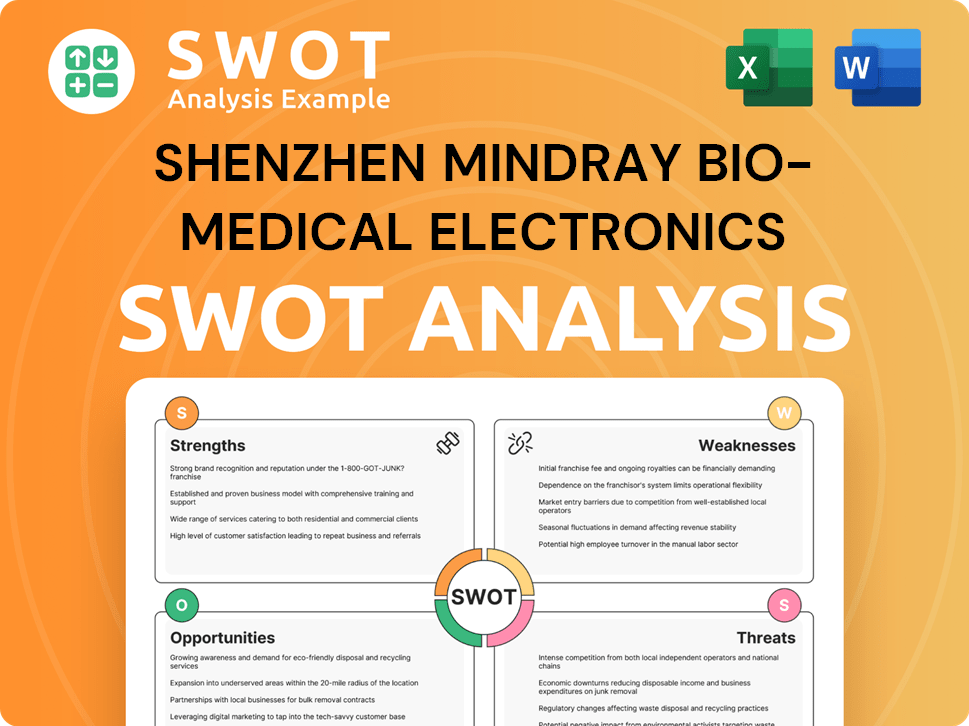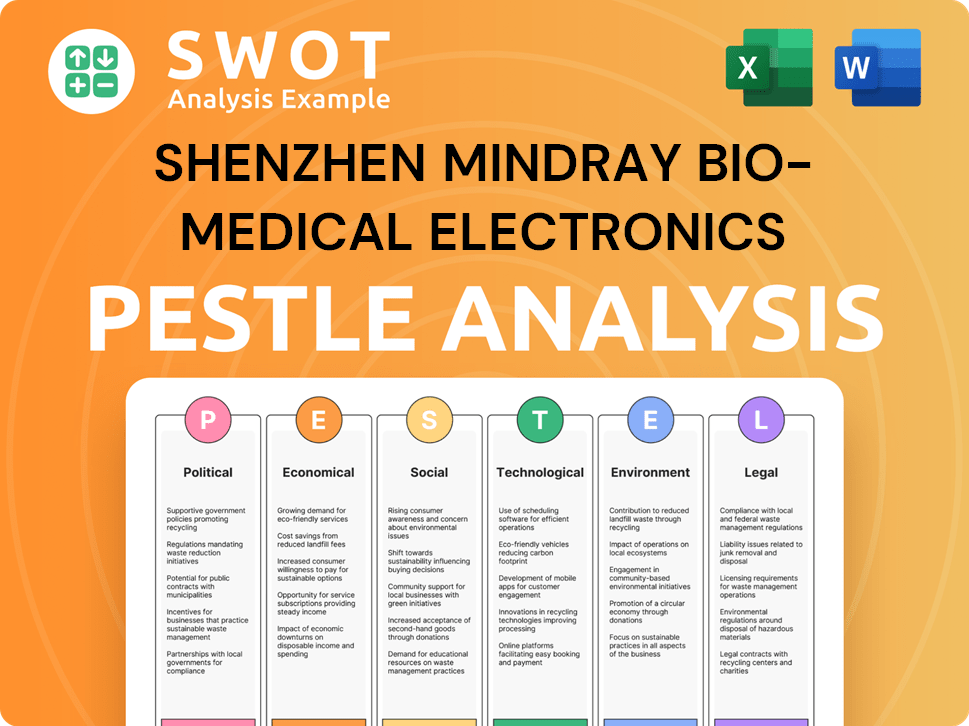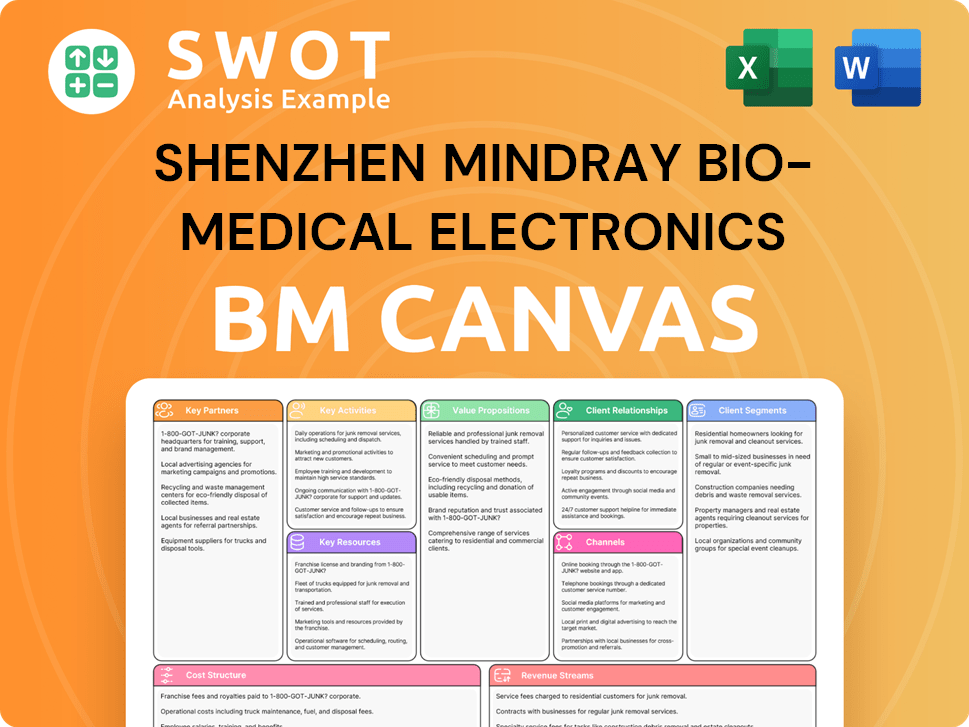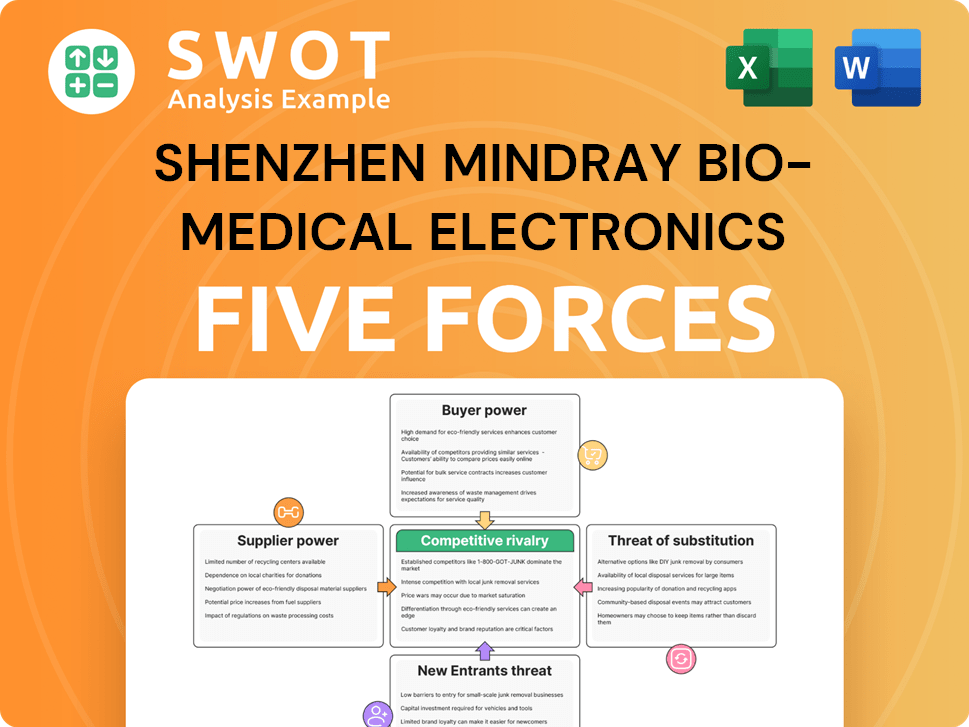Shenzhen Mindray Bio-Medical Electronics Bundle
How Does Mindray Dominate the Global Medical Device Market?
Shenzhen Mindray Bio-Medical Electronics Company, a global leader in medical technology, has achieved remarkable success by strategically targeting its customer base. Understanding the intricate details of Mindray's Shenzhen Mindray Bio-Medical Electronics SWOT Analysis is crucial for grasping its market position. This exploration delves into the company's customer demographics and target market, revealing the secrets behind its impressive growth and sustained market share.

This comprehensive
Who Are Shenzhen Mindray Bio-Medical Electronics’s Main Customers?
Understanding the primary customer segments is crucial for analyzing the market position of Shenzhen Mindray Bio-Medical Electronics Company. Mindray, as a business-to-business (B2B) entity, focuses on healthcare institutions. This includes hospitals, clinics, and diagnostic centers worldwide, which represent its core target market.
The characteristics of these institutional clients are defined by factors such as the size and type of healthcare facility, their technological capabilities, and their budgetary constraints. These segments are key to understanding Mindray's market dynamics and strategic positioning. Analyzing the target market helps in understanding the company’s competitive advantages.
Mindray's approach involves catering to a wide spectrum of needs. This ranges from high-end products for advanced medical institutions to mid- and low-end products suitable for various client requirements, particularly in developing regions. This strategy allows it to capture a broader market share and maintain a competitive edge.
Hospitals, especially those adopting advanced medical imaging technologies, constitute a significant portion of Mindray's market. In 2024, hospitals held a 48.7% share within the medical imaging devices market. This segment is critical for Mindray's revenue generation.
Diagnostic imaging centers represent a rapidly growing segment. They are projected to have a Compound Annual Growth Rate (CAGR) of 6.4%. This growth highlights the importance of this segment for future expansion and market share gains for Mindray.
Mindray's strategy includes technological innovation and strategic acquisitions to expand its market share. The acquisition of Huatai Medical in 2024 is a strategic move to strengthen its presence in the cardiovascular sector. This also expands its high-value consumables, which are significant profit sources.
- The company's focus on hospitals and diagnostic centers is a key part of its customer demographics.
- Mindray’s target market also includes clinics and other healthcare providers globally.
- The company's global market presence is supported by its sales and distribution channels.
- Mindray’s customer acquisition strategy is focused on providing advanced medical solutions.
For more insights into the ownership and financial aspects of the company, you can explore Owners & Shareholders of Shenzhen Mindray Bio-Medical Electronics.
Shenzhen Mindray Bio-Medical Electronics SWOT Analysis
- Complete SWOT Breakdown
- Fully Customizable
- Editable in Excel & Word
- Professional Formatting
- Investor-Ready Format

What Do Shenzhen Mindray Bio-Medical Electronics’s Customers Want?
Understanding the customer needs and preferences is crucial for Shenzhen Mindray Bio-Medical Electronics Company (Mindray). Their primary customers, which include healthcare facilities, have specific requirements that drive their purchasing decisions. These needs shape the company's product development and market strategies, ensuring they meet the demands of the healthcare industry.
Mindray's ability to meet these needs is reflected in its product offerings and market performance. The company focuses on innovation, quality, and affordability to cater to a diverse customer base. This approach allows Mindray to maintain a strong position in the competitive bio-medical electronics market.
The target market for Mindray is primarily healthcare facilities globally. These include hospitals, clinics, and other medical institutions that require advanced medical equipment. The company's focus on innovation and integration of its products with existing hospital systems is a key factor in its success. Mindray's commitment to addressing the pain points of its customers, such as inadequate medical resources, further solidifies its market position.
Mindray's customers seek equipment that delivers accurate and reliable diagnostic results. This includes advanced imaging technologies, such as ultrasound machines, and precise patient monitoring systems. The demand for better diagnostic tools drives Mindray to continually improve its product accuracy and capabilities.
Healthcare facilities aim to provide the best possible treatment for their patients. Mindray supports this by offering equipment that aids in effective treatment delivery. This includes devices that facilitate real-time patient data monitoring and analysis.
Efficiency is a key concern for healthcare providers. Mindray's products are designed to streamline clinical processes, reduce manual tasks, and integrate seamlessly with existing systems. This helps healthcare providers save time and resources.
Healthcare facilities must manage costs effectively. Mindray's equipment is designed to be cost-effective, with features that reduce operational expenses. This includes solutions that minimize the need for extensive training and maintenance.
Customers value cutting-edge technology that can improve patient care. Mindray invests heavily in research and development, incorporating the latest advancements, such as AI, into its products. This focus on innovation helps the company stay ahead of market trends.
Healthcare providers require equipment that is dependable and performs consistently. Mindray ensures high quality through rigorous testing and adherence to strict standards. This reliability is crucial for ensuring accurate diagnoses and effective treatments.
Mindray's customer acquisition strategy involves a combination of direct sales, partnerships, and participation in industry events. The company also focuses on providing comprehensive training and support to its customers, ensuring they can effectively utilize the equipment. Mindray's global market presence is supported by a robust sales and distribution network, allowing it to reach healthcare facilities worldwide. As of 2024, Mindray's revenue reached approximately $4.2 billion, reflecting its strong market position and customer satisfaction. The company's commitment to innovation and customer needs continues to drive its growth, making it a significant player in the global bio-medical electronics market. To learn more about the company's journey, read the Brief History of Shenzhen Mindray Bio-Medical Electronics.
Shenzhen Mindray Bio-Medical Electronics PESTLE Analysis
- Covers All 6 PESTLE Categories
- No Research Needed – Save Hours of Work
- Built by Experts, Trusted by Consultants
- Instant Download, Ready to Use
- 100% Editable, Fully Customizable

Where does Shenzhen Mindray Bio-Medical Electronics operate?
The geographical market presence of Shenzhen Mindray Bio-Medical Electronics is extensive, with a global footprint that spans over 190 countries and regions. This widespread reach allows the company to serve healthcare facilities worldwide, establishing it as a key player in the global bio-medical electronics market. The company's strategic approach to market expansion is evident in its diverse international operations.
Mindray has strategically positioned itself with a significant number of overseas subsidiaries. It operates through 51 overseas subsidiaries across 42 countries and 21 domestic subsidiaries, along with more than 30 branches within China. This robust network supports its global research and development, marketing, and service efforts. The company's focus on both established and emerging markets highlights its adaptable business strategy.
Mindray's global strategy includes a strong presence in established markets like Germany, the United Kingdom, France, and Italy, while also focusing on high-growth emerging markets. In 2024, the company's overseas revenue grew by 21.3% year-on-year, accounting for 44.7% of its total revenue. This growth demonstrates the company's ability to capitalize on opportunities in diverse regions, making it a subject of interest in Revenue Streams & Business Model of Shenzhen Mindray Bio-Medical Electronics.
Emerging markets, excluding North America, saw a 26% year-on-year increase in revenue. The Asia-Pacific region continues to be a major growth engine. Developing countries such as Mexico, Brazil, Indonesia, and Turkey experienced rapid growth, exceeding 30% in the first quarter of 2024.
Despite a high base, the US market has also maintained steady growth, with a compound growth rate of 18% for two consecutive years. This indicates strong market penetration and customer acceptance of Mindray's products in a competitive environment.
Mindray localizes its offerings, marketing, and partnerships to succeed in diverse markets. For example, in 2024, the company signed a strategic cooperation agreement with Egypt's largest private hospital group, Cleopatra Hospitals Group. This approach helps the company tailor its strategies to meet the specific needs of different regions.
The company's 'Project 2025' initiative engages worldwide experts for basic education and training, cutting-edge technology exchanges, and medical research cooperation to advance global ultrasound medicine. This initiative supports Mindray's goal of promoting global health standards and innovation.
Mindray anticipates overseas revenue to grow by a mid-teens percentage in 2025. This projection reflects the company's confidence in its global strategy and its ability to adapt to changing market conditions. This growth will likely be driven by both expansion in existing markets and entry into new regions.
Shenzhen Mindray Bio-Medical Electronics Business Model Canvas
- Complete 9-Block Business Model Canvas
- Effortlessly Communicate Your Business Strategy
- Investor-Ready BMC Format
- 100% Editable and Customizable
- Clear and Structured Layout

How Does Shenzhen Mindray Bio-Medical Electronics Win & Keep Customers?
The customer acquisition and retention strategies of Mindray, a leading player in the bio-medical electronics sector, are primarily geared towards the B2B market, focusing on hospitals and clinics. Their approach involves a blend of direct sales, strategic partnerships, and participation in industry-specific events. This multifaceted strategy is designed to expand their market reach and solidify their position within the healthcare industry.
Mindray's marketing efforts are also crucial in attracting and retaining customers. They employ digital marketing campaigns, collaborations with key industry influencers, and the publication of case studies to demonstrate the value of their products. The company also emphasizes providing superior after-sales support and incentivizing customer referrals, which are key components of their retention strategy.
The company's strategy includes a strong emphasis on continuous innovation and a global presence. Acquisitions, such as the 2024 acquisition of Huatai Medical, are part of their long-term customer relationship strategy. Mindray also aims to improve retention rates by 15% through superior after-sales support by the end of 2025.
Mindray uses a direct sales force to engage with hospitals and clinics. They also partner with distributors, especially to reach rural areas. These partnerships help expand market access and increase sales volume.
The company actively participates in medical equipment expos and healthcare conferences. Mindray also targets government and institutional tenders to secure contracts and increase brand visibility.
Mindray runs digital marketing campaigns targeting healthcare professionals. They develop partnerships with influential industry players, leveraging their reach and credibility to promote products and services.
They publish case studies, product demos, and success stories to highlight the return on investment (ROI) benefits. The focus is on showcasing the value and efficiency of their high-end medical equipment.
Mindray's customer retention strategies center on superior after-sales support and incentives for customer referrals. This approach is enhanced by leveraging customer data and providing omnichannel support in multiple languages.
- After-Sales Support: Offers comprehensive support to maintain customer satisfaction and loyalty.
- Referral Programs: Incentivizes existing customers to recommend Mindray's products to other hospitals and clinics.
- Customer Data and Segmentation: Uses data analytics to understand customer needs and tailor services.
- Multilingual Support: Provides support in English, Spanish, Arabic, and Russian to enhance customer experience.
For a deeper dive into the company's marketing strategies, including how it approaches customer acquisition and retention, you can explore the Marketing Strategy of Shenzhen Mindray Bio-Medical Electronics.
Shenzhen Mindray Bio-Medical Electronics Porter's Five Forces Analysis
- Covers All 5 Competitive Forces in Detail
- Structured for Consultants, Students, and Founders
- 100% Editable in Microsoft Word & Excel
- Instant Digital Download – Use Immediately
- Compatible with Mac & PC – Fully Unlocked

Related Blogs
- What are Mission Vision & Core Values of Shenzhen Mindray Bio-Medical Electronics Company?
- What is Competitive Landscape of Shenzhen Mindray Bio-Medical Electronics Company?
- What is Growth Strategy and Future Prospects of Shenzhen Mindray Bio-Medical Electronics Company?
- How Does Shenzhen Mindray Bio-Medical Electronics Company Work?
- What is Sales and Marketing Strategy of Shenzhen Mindray Bio-Medical Electronics Company?
- What is Brief History of Shenzhen Mindray Bio-Medical Electronics Company?
- Who Owns Shenzhen Mindray Bio-Medical Electronics Company?
Disclaimer
All information, articles, and product details provided on this website are for general informational and educational purposes only. We do not claim any ownership over, nor do we intend to infringe upon, any trademarks, copyrights, logos, brand names, or other intellectual property mentioned or depicted on this site. Such intellectual property remains the property of its respective owners, and any references here are made solely for identification or informational purposes, without implying any affiliation, endorsement, or partnership.
We make no representations or warranties, express or implied, regarding the accuracy, completeness, or suitability of any content or products presented. Nothing on this website should be construed as legal, tax, investment, financial, medical, or other professional advice. In addition, no part of this site—including articles or product references—constitutes a solicitation, recommendation, endorsement, advertisement, or offer to buy or sell any securities, franchises, or other financial instruments, particularly in jurisdictions where such activity would be unlawful.
All content is of a general nature and may not address the specific circumstances of any individual or entity. It is not a substitute for professional advice or services. Any actions you take based on the information provided here are strictly at your own risk. You accept full responsibility for any decisions or outcomes arising from your use of this website and agree to release us from any liability in connection with your use of, or reliance upon, the content or products found herein.